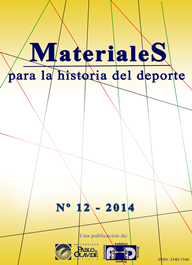El dopaje y el antidopaje en perspectiva histórica
Palabras clave:
dopaje, antidopaje, historia, AMA.Resumen
El dopaje ha sido un fenómeno cambiante a lo largo de la historia. Para dar cuenta de ello hemos realizado una periodización que distingue entre a) dopaje natural o naturista; b) dopaje químico simple o de primera generación; c) dopaje químico sistematizado o de segunda generación y, d) dopaje biotecnológico. En la segunda parte del texto, nuestra atención se centrará en analizar la reacción que las diversas instituciones deportivas internacionales han tenido ante el dopaje. En esta periodización de la lucha antidopaje se hará hincapié en la creación de la Agencia Mundial Antidopaje (AMA), y en el que será el nuevo texto del Código Mundial Antidopaje que entrará en vigor en 2015.
Descargas
Referencias
A. Miah, Genetically modified athletes:biomedical ethics, gene doping and sport, (Routledge, London and New York, 2004).
A. Ramos Gordillo, Dopaje y Deporte. Antecedentes y Evolución, (Universidad de Las Palmas de Gran Canaria. Servicio de Publicaciones, Las Palmas de Gran Canaria, España, 2000).
Barrie Houlihan, Dying to Win: Doping in Sport and the Development of an Anti-Doping Policy, (Estrasburgo, Council of Europe, 1999).
Charles E. Vesalis, “History of Drugs in Sport”, en International Sports Studies, vol. 24, n.1, 2002, pp. 42-76.
Daniel M. Rosen. Dope: A History of Performance Enhancement in Sports from Nineteenth Century to Today, (Westport (CT), Praeger Publishers, 2008).
E. Gamero Casado, “El dopaje en los ámbitos supranacionales: evolución histórica y situación actual”, en Régimen jurídico del dopaje en el deporte, A. Millán Garrido (Coordinador), Colección «Derecho y Deporte», Editorial Bosch, Barcelona, España, 2005, pp. 30-33
Fred C. Pampel, Drugs and Sports, (New York, Facts on File, 2007).
IrenaMartinkova, Intrumentality and Values in Sport, (Karolinum, Praga, 2013).
J.L.Neyro Bilbao, “Medicina deportiva” (técnico) y D. Malo De Molina, «Medicina deportiva» (jurídico), en Enciclopedia de Bioderecho y Bioética, Tomo II, C.M. Romeo Casabona (Director), (Editorial Cátedra Interuniversitaria de Derecho y Genoma Humano — Comares, Bilbao-Granada, España, 2011).
John Hoberman, Sport and political ideology, Austin, University of Texas Press, 1984.
José Luis Pérez Triviño, Ética y deporte, (Bilbao, Descleé de Brouwer, 2011).
José Luis Pérez Triviño. "Cyborgsportpersons: Between Disability and Enhancement”; Physical Culture and Sport. Studies and Research. Volume 57, Issue 1, March 2013.
José Luis Pérez Triviño. ”Deportistas tecnológicamente modificados y los desafíos al deporte"; Revista de Bioética y Derecho, núm. 24, enero 2012, p. 3-19
Paul Dimeo, A History of Drug Use in Sport 1876-1976,( New York, Routledge, 2007).
Rob Beamish, Fastest, highest, strongest: a critique of high-performance sport, (New York, Routledge, 2006)
Thomas Hunt, Drug Games: The International Olympic Committee and the Politics of Doping, 1960-2008, (Austin, University of Texas Press, 2011).
Young, David C. The Olympic Myth of Greek Amateur Athletics, (Chicago, Ares Publishers, 1984).
Descargas
Publicado
Número
Sección
Licencia
Aquellos autores/as que tengan publicaciones con esta revista, aceptan los términos siguientes:- Los autores/as conservarán sus derechos de autor y garantizarán a la revista el derecho de primera publicación de su obra, el cuál estará simultáneamente sujeto a la Licencia de reconocimiento de Creative Commons que permite a terceros compartir la obra siempre que se indique su autor y su primera publicación esta revista.
- Los autores/as podrán adoptar otros acuerdos de licencia no exclusiva de distribución de la versión de la obra publicada (p. ej.: depositarla en un archivo telemático institucional o publicarla en un volumen monográfico) siempre que se indique la publicación inicial en esta revista.
- Se permite y recomienda a los autores/as difundir su obra a través de Internet (p. ej.: en archivos telemáticos institucionales o en su página web) antes y durante el proceso de envío, lo cual puede producir intercambios interesantes y aumentar las citas de la obra publicada. (Véase El efecto del acceso abierto).












